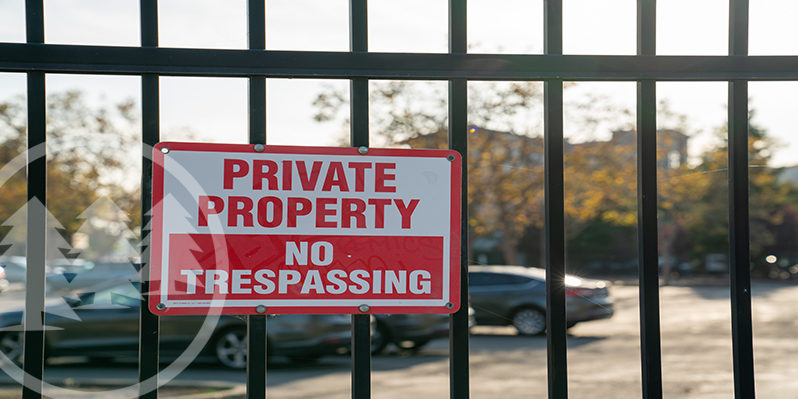Believe it or not, trespassing in HOA communities is a common point of concern. Whether the situation involves the HOA entering a homeowner’s property or a homeowner entering community property, it is important for any association to know how to handle this issue. Failure to do so can result in serious consequences for both parties.
Defining Trespassing in HOA Communities
It is critical to define what counts as trespassing within the context of a homeowners association. Trespassing means entering a person’s property without their permission. Generally, a member of the HOA community can only enter a fellow member’s property for the following reasons:
- To conduct maintenance work or repairs on a common element
- To inspect for violations of the covenants or operating rules
- In case of emergencies
Of course, the association must provide the homeowner with sufficient prior notice of the intent. The lead time varies from association to association, so it is imperative to check the governing documents for such provisions.
Learn to Discern a Trespass from a Violation
 The unauthorized entry into a property does not always equate to trespassing. For instance, an association may have a rule that only allows homeowners in the community pool area during specific hours.
The unauthorized entry into a property does not always equate to trespassing. For instance, an association may have a rule that only allows homeowners in the community pool area during specific hours.
If a homeowner enters the pool area outside of those hours, the HOA may feel tempted to charge the homeowner with trespassing. However, most experts agree that classifying this as trespassing seems extreme.
Associations must learn to differentiate between trespassing in HOA communities and a mere violation of the rules. In the above scenario, the homeowner broke a rule about the community pool hours.
Calling the police on the violator is an exaggerated reaction. Instead, the HOA can simply charge the homeowner with a fine and move on.
It is, however, considered HOA trespassing if the person entering the pool (or any other common area) is not a member of the HOA community. The same goes for people who are unapproved tenants residing on a property or those in a foreclosed property. The association can charge the violators in this case with trespassing.
What to Do Before Entering a Homeowner’s Property
While the association can enter a homeowner’s property under a few circumstances, the HOA must first ask itself whether it should. Mishandling the situation can result in a wide array of consequences. Therefore, the HOA must act cautiously when it comes to entering a homeowner’s property for correcting a violation. Some may perceive it as trespassing. Here are the things an association must take into account:
1. Check the Governing Documents and State Laws
The first thing the HOA board must do is to check state laws and the association’s governing documents. An association’s Declaration of Covenants, Conditions, and Restrictions (CC&Rs) should contain provisions outlining the HOA board’s authority to enter a homeowner’s property. It is crucial to pinpoint exactly which part of the documents gives the board the power to enter someone’s property and take the intended actions. Just because the Declaration allows the HOA to enter a homeowner’s property does not mean it has the authority to install or alter anything without permission.
State laws may also play a part in allowing associations access to homeowner property. In California, for instance, homeowners associations, treated as landlords, have the right of entry under emergency situations. It is important to note that, if state laws and an association’s CC&Rs come into conflict, the former always trumps the latter.
2. Consider the Risks
 After determining whether state laws or the association’s CC&Rs permit entry, the HOA must then evaluate the risks against the benefits.
After determining whether state laws or the association’s CC&Rs permit entry, the HOA must then evaluate the risks against the benefits.
The homeowner may be in violation of the rules, but entering their property will not always solve the situation. The most common pitfalls involved are:
- Possibly angering the homeowner involved
- The physical safety of the association’s representative
- Legal repercussions (in this case, being charged as trespassers in HOA community)
Some people will go to any lengths, however extreme, to safeguard their property. If a combative homeowner is concerned about their property rights, the HOA representative may face danger. Residents may also own aggressive pets that can seriously injure the representative. If a homeowner phones the authorities, the police typically ignore the association’s “self-help” provisions in the CC&Rs. Instead, they will likely take the homeowner’s side and ask the HOA to vacate the premises.
3. Get a Court Order
If the situation definitely calls for entry into a homeowner’s property, the association must obtain a court order. This is the absolute last resort an HOA must consider. Before getting a court order, the association must exhaust all possible alternative courses of action first, including providing sufficient notice, imposing fines, or even organizing a hearing. Taking legal action can be costly and time-consuming, so it must not take precedence over all other options.
After doing everything in its power to resolve the issue and still arriving at a fruitless outcome, the HOA can then involve an attorney. Legal counsel can send a letter to the homeowner in question. This letter will double as documentary proof that the HOA attempted to resolve the matter through all possible means. If the homeowner still does not remedy the violation, the HOA can proceed with litigation and obtain a court order. This court order will allow the association access to the homeowner’s property to correct the violation.
It Is Not Always Black and White
Every association must deal with trespassing in HOA communities at one point or another. In such circumstances, it is important to remember that not everything is in black and white. Before confronting the situation head-on, the HOA must step back and consider all the elements. Determine whether it counts as trespassing, check the state laws and governing documents, and weigh the pros and cons of entering a homeowner’s property.
Many associations struggle with enforcing HOA trespassing policies and dealing with violators, which is why a vast majority turn to professional HOA management services. Feel free to contact us online, call us at (877) 252-3327, or email us.
RELATED ARTICLES:
- What Are The HOA Governing Documents You Need As A Homeowner?
- HOA Flag Rules: Can The HOA Restrict You From Raising A Flag?
- Is Getting A D And O Insurance For The HOA Board Necessary?






